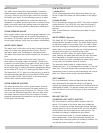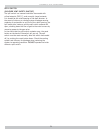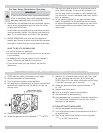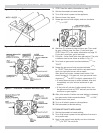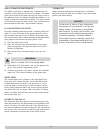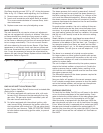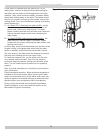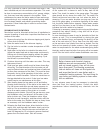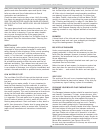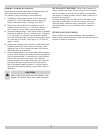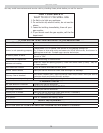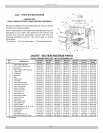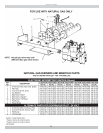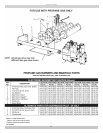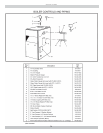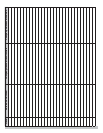
28
MAINTAINING YOUR BOILER
Keep boiler area clear and free from combustible materials,
gasoline and other fl ammable vapors and liquids. Keep
boiler are clear and free of obstructions to fl ow of
combustion and ventilation air.
Check the water level every day or two. Verify the water
line shown by operating the drain valve on the gauge. BE
SURE TOP AND BOTTOM VALVES ON GAUGE ARE ALWAYS
OPEN SO THAT ACTUAL WATER LEVEL WILL BE SHOWN AT
ALL TIMES.
The gauge glass should be dry above the water line. The
water line should not bounce more than about one inch
when the boiler is steaming. If you see water droplets
carrying over through the top of the gauge glass, or
excessive bouncing of the water line, the boiler needs to
be cleaned. Follow the instructions under “Cleaning Your
Boiler.”
SAFETY VALVE
Before testing, make certain discharge pipe is properly
connected to valve outlet and arranged to contain and
safely dispose of boiler discharge. Under normal operating
conditions a “try lever test” must be performed every
month. A “try lever test” must also be performed at the
end of any non-service period. Test at normal system
operating pressure by holding the test lever fully open
for at least fi ve seconds to fl ush the valve seat free of
sediment and debris. Then release lever and permit the
valve to snap shut. If lift lever does not activate, or there
is no evidence of discharge, turn off boiler immediately and
contact a licensed contractor or qualifi ed service personnel.
LOW WATER CUT-OFF
The Low Water Cut-Off will interrupt the electrical current
to the burner when the water line in the boiler drops to a
low level.
On fl oat type low water cutoffs, it is very important to
keep the fl oat chamber free from sediment, a condition
essential to dependability. To keep any accumulation from
interfering with fl oat action is to “BLOW DOWN” or fl ush out
the control regularly. This must be done two to three times
during the fi rst week after installation and once a week
thereafter during the heating season. Do it while the boiler
is in operation. First note water level in gauge glass. Open
blow-off valve at bottom of control; water will pour out,
fl ushing away sediment. Drain until water is clear, about a
pailful, then close valve. If water level in gauge glass has
dropped, add water to boiler to restore level. Consult low
water cut-off manufacturer’s instructions included with
boiler.
NOTE: Opening blow-off valve checks cut-off operation
too. As fl oat drops with falling water level, burners will shut
off. After valve is closed and normal operating conditions
are restored, burners will resume fi ring. For probe type
Low Water Cutoffs, check action of the Low Water Cut-Off
monthly to make sure it is providing the proper protection.
See “Checking and Adjusting” on page 19. Low Water Cut-
Off remote probes must be removed for periodic inspection
and cleaning, preferably at the beginning of each heating
season. More frequent cleaning may be required on boilers
requiring constant or very frequent additions of make up
water.
BURNERS
A visual check of the pilot and main burner fl ames should
be made at least once each year, preferably at the begin-
ning of the heating season. See page 19.
BOILER FLUE PASSAGES
Under normal operating conditions, with the burners
properly adjusted, it should not be necessary to clean the
boiler fl ue gas passages. However, to assure trouble-free
operation, we recommend that you have the fl ue passages,
burner adjustment,
and operation of the controls checked once each year by a
competent Service Technician.
Before the start of each season (or whenever system has
been shut down for some time) recheck the whole sys-
tem for leaks . . . and recheck the boiler and vent pipe for
leaks.
VENT PIPE
The venting of this unit is very important and the piping
should be checked at least once a season. If the vent pip-
ing shows any sign of leaking, replace it immediately.
CLEANING YOUR BOILER FLUE PASSAGES AND
BURNERS
Flue Passages between sections should be examined yearly
and cleaned, if necessary. To clean, remove burners, pilot,
and vent pipe. Remove top and front jacket panels. Remove
the two screws attaching the intermediate front panel to
the left and right side jacket panels. Remove the draft
diverter and intermediate front panel as a unit. Carefully
remove the cerafelt gasket strips. Clean passageways
between sections with a fl exible handle wire brush. Remove
dirt from bottom of boiler and from between sections by
vacuuming. Make sure all fl ame ports in burners are open
and clear. Shake out or blow out all loose dirt in burners.
Reseal seams between adjacent sections as necessary with
400F RTV silicone sealant. Reassemble all parts. Be sure to
check tightness of pilot connections and condition of burner
fl ames after reassembly (see Figures 18 and 19).
Be sure vent pipe connections to chimney are secure and
no obstructions are present.



